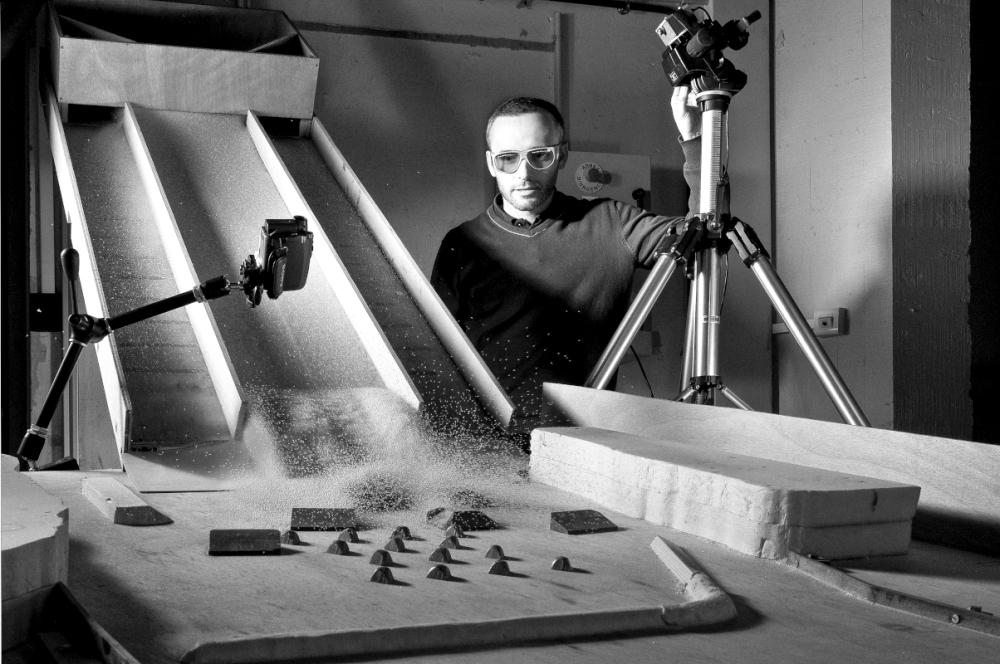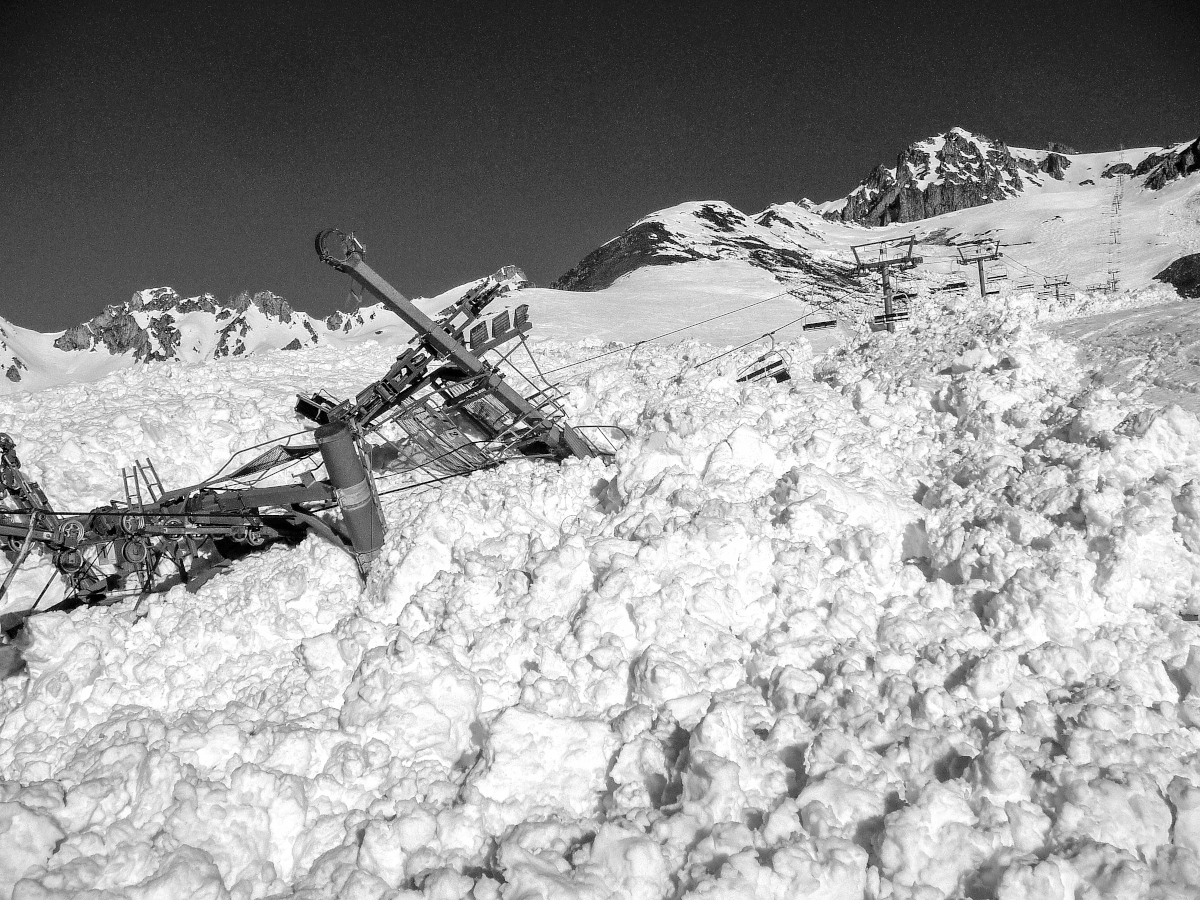Ressources dossier
Climate change and risksMulti-faceted research
Published on 02 February 2023
“The physics of avalanches continues to be a key area for investigation … The scale of our work extends from snow grains to mountain ranges”, explains Florence Naaim, deputy director of the Institute of Environmental Geosciences (IGE) joint research unit. Indeed, where avalanches are concerned, “you can only make sense of the very large things if you know the tiny things”, she says. Observation, experimentation and modelling form the tryptich of research activities that generate the necessary knowledge to improve anticipation and preparedness.
On the mountain: working at landscape scale
The IGE researchers use a series of local investigation sites to carry out their observations. Of these, one exceptional site, the Lautaret avalanche test site in the Hautes-Alpes, has, since 1973, served as a rich source of data on avalanche dynamics. With the help of a gas explosive device, the team can artificially trigger avalanches on site, analysing their every feature. “We study their characteristics, for example, their speed or the volume of snow they displace. Our imaging systems allow us to record an avalanche using a rapid camera, or in 3D, so we can gain a better understanding of the interactions between the avalanche and the local terrain. We use sensors fixed to an obstacle along the avalanche’s route to measure how much pressure it exerts”, Emmanuel Thibert, a researcher in the IGE unit, explains.
Setting up this system “meant that we could demonstrate quite how much snow an avalanche can bring down – up to ten times the volume of the snow in motion in the starting zone. And it allowed us to show that the coefficient that was being used at that time to calculate the pressure exerted on an obstacle based on an avalanche’s speed and density had been grossly underestimated (by a factor of 10) in zones with slow speeds (run-out zones)”, Florence Naaim tells us.
High up on the wind-swept pass known as the Col du Lac-Blanc which sits at 2,700 metres above sea-level near the Alpe-d’Huez ski station in the Val d’Isère, INRAE’s researchers are also studying the interactions between snow and wind, working with their colleagues from the Snow Study Centre at the CNRM (the French National Centre for Meteorological Research). Indeed, wind is a key factor in the triggering of avalanches. It affects how the snow is deposited and creates cornices or wind loads that can, at any moment, lead to avalanches. “A natural wind tunnel where we have been recording measurements for 30 years, this site has made it possible to test out new measurement techniques and to build a unique climate database which has at tracted scientific teams from both Austria and Japan. Our sensors are effectively able to record the movement of hundreds of tonnes of snow per linear metre of ridge each year”, says Florence Naaim.
In the lab: physical models and x-ray machines
But it is not enough to study how avalanches behave out on the mountain. To gain an understanding of the way that each snow grain moves against its fellows, how it speeds up or slows down, other methods are needed. Here, reduced-scale models come into their own, making it possible to set up experiments on the dynamics of snow flows. “We use two analogous physical processes”, says Thierry Faug, one of the unit’s researchers and an engineer. “For dense dry flow avalanches, we simulate the behaviour of the dry snow grains in terms of their cohesion and friction using glass beads and PVC powder. For powder avalanches, we release a flow of heavy fluid such as salt water into a lighter fluid, such as clear water. The heavy fluid allows us to simulate the mixture of air and suspended ice particles that make up this sort of avalanche.”

But it is not enough to study how avalanches behave out on the mountain. To gain an understanding of the way that each snow grain moves against its fellows, how it speeds up or slows down, other methods are needed. Here, reduced-scale models come into their own, making it possible to set up experiments on the dynamics of snow flows. “We use two analogous physical processes”, says Thierry Faug, one of the unit’s researchers and an engineer. “For dense dry flow avalanches, we simulate the behaviour of the dry snow grains in terms of their cohesion and friction using glass beads and PVC powder. For powder avalanches, we release a flow of heavy fluid such as salt water into a lighter fluid, such as clear water. The heavy fluid allows us to simulate the mixture of air and suspended ice particles that make up this sort of avalanche.”
But an even closer examination is required to be able to identify the laws that govern the changes in form and the flows within the snowpack during an avalanche. “The snow’s mechanical properties depend on its micro-structure”, Guillaume Chambon, researcher at the IGE unit tells us. To access this microstructure, the research team uses x-ray tomography machines. “These machines allow us to observe details that are just a few micrometres in size. This enables us to study changes in the snow as a function of various parameters such as temperature or pressure and to build three-dimensional models to explore the material’s mechanical response using virtual experiments”, the researcher adds.
Going virtual: digital models to process and exploit the data
Integrate knowledge on scales ranging from the microscopic to a whole mountainside in a single model to understand the avalanches of the future.
Full benefit can only be gained from the practical observations and experiments described above, though, especially in the realm of forecasting, if the unit carries out further work, this time using digital modelling to process the results. What makes digital modelling so necessary? “We are trying to integrate knowledge on scales ranging from the microscopic to a whole mountainside in a single model”, Guillaume Chambon explains. The models and digital simulations allow the team to set off virtual avalanches, varying the start parameters. By then combining their models with the IPCC’s climate predictions, they can build a picture of the future characteristics of avalanches. This combination of methods has already borne fruit. The models for dense and powder avalanches are already very reliable and, for example, allow the team to make detailed recommendations on the anti-avalanche structures that should be installed on the ground.
Now, though, the changing climate calls for further research on wet avalanches, which are formed of a mixture of liquid water and ice and whose dynamics are not yet well understood. Here, observation, experimental work and modelling will doubtless once again turn out to be a winning combination as we improve our knowledge of this complex phenomenon, and will help us to optimise our predictive tools.
Climate: Wet avalanches as an emerging risk
One of the main developments brought about by climate change is the increase in the frequency of wet avalanches. Faced with this emerging risk, some sites are ill-prepared for the impacts.
The flows generated by wet avalanches, when these occur earlier in the winter season, can set large volumes of snow and water into motion. They also have high pressure loads, of the order of 10 t/m2, despite their slow-moving character and can cause significant damage. In some extreme cases, when they contain a very high proportion of water, such flows can cover astonishingly long distances, ranging from several hundred metres to a kilometre in length and exceeding their usual boundaries. A further problem lies in the fact that the dynamics of wet avalanches are not yet fully understood: “We have come up against the limits of our knowledge of these events. We haven’t yet managed to create satisfactory models of how they behave”, Thierry Faug, a researcher in the IGE unit confesses ruefully. This current limitation has consequences, because the protection provided by anti-avalanche structures installed in many mountain locations is designed for cold and dry snow avalanche scenarios. When a large wet avalanche hits, there is a chance that these protective structures could, in some cases, prove insufficient.

The need to revisit existing protection systems
In such cases, active defence structures, such as racks, nets, screens or windmill structures, designed to prevent avalanches from being triggered at the tops of the slopes, could be swept away or could fail to do their job. As the climate continues to heat, the creep behaviour of the snow has changed as a consequence of its increased wetness. “The higher water content makes the snow heavier and causes more slides in the snowpack, increasing the pressure exerted on structures”, Thierry Faug explains. The structures must also be designed to resist greater future pressures, so they will be able to cope with the changing nature of the snowpack and starting conditions for avalanches. Equally, care will have to be taken with regard to the siting of new structures in locations where slides at the snowpack base have previously been rare.
Passive defences could also be affected by this change in the snow’s water content. Such devices are intended to slow, divert or halt an avalanche and take the form of braking mounds, diversion berms or catching dams. However, in some locations, the margin of protection provided by these structures against hazards is already narrow. To complicate matters, the routes of wet avalanches can sometimes confound expectations by failing to follow the steepest slopes. A high-volume wet avalanche, because its trajectory is difficult to predict, could thus overwhelm passive structures and cause damage. The message is clear: it is not yet time to panic, but preparations should be made. Thierry Faug, provides some reassurance: “There is no need to reinvent our anti-avalanche strategies. There are some locations, though, where we will need to upgrade the structures to reduce vulnerability and will need to plan in particular for a wet snow scenario that would either supplement or replace the dry snow scenarios”. Upgrading has already begun, as the Institute’s researchers continue to collaborate with the mountain authorities to introduce the appropriate adaptations.
-
Sebastiàn Escalon & ETNA Research Unit
Authors / Translated by Teresa Bridgeman
-
Thierry Caquet, Mohamed Naaïm & Patrick Flammarion
Scientific direction
-
Lou Rihn
Illustrator
